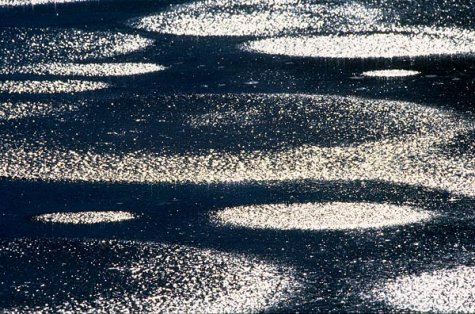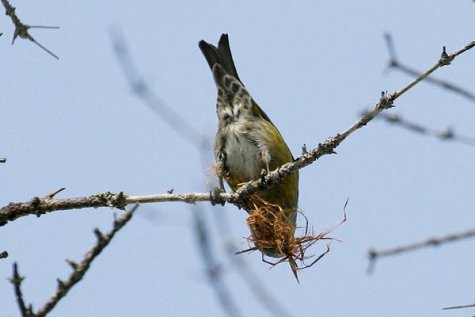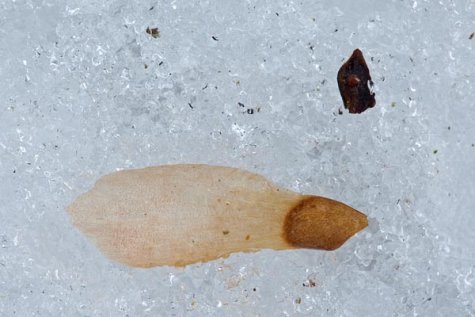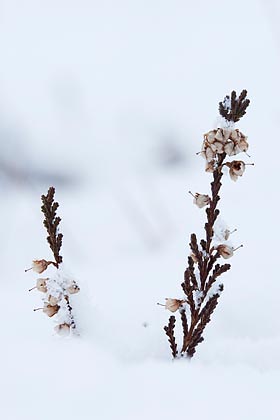Photos: Arne Ader
Text: Kristel Vilbaste
Translation: Liis from Forum

Be cautious on ice! The ice is melting!
The beginning of spring came with bright sunshine in most of Estonia, but with snowdrifts up to the window-sills too. Haanja’s south-east corner with 54 cm and Otepää with 52 cm had the most snow. The Sõrve säär peninsula again had no snow at all.
The four late-winter signs:
White hare
Freezing lapwing
Lonely flower tuft on hazel
Half-metre thick snow.
The winter capital, Otepää, holds so tightly on to winter that it is even difficult to see somebody behind the snow banks. At the same time nearby, around Põlva, the snow carpet is only half as thick, and the south-turned slopes of roads and creek-shores are so bare that you get vivid images of hepaticas already blooming. But there is blue, in the snowdrifts. Environmentalist Enn Vilbaste says that he can only remember seeing such luminous sheer light blue as on these snowdrifts in the sunshine in spring-time ice banks on shores. This light effect is so beautiful that if the sun shines it is worth getting out at once to see it. The coming of Maarjapäev, Annunciation day, on March 25th, insists that we acknowledge that spring is here – Mikk Sarv says that from that day on people of old did not light any lights indoors in the evenings, the dusk was spent telling stories and making plans for the summer. Straws began hating the snow – snow melts around them - and farm-hands were hired.

Spruce seeds spill out, and crossbills build nests.
Freezing birds
There is not much new to tell from the world of spring birds when writing about last week’s snowy happenings. A few freezing lapwings did come to near Tartu, but most of them turned their beaks the other way again in the beginning of the week and flew back to Latvia. The tits too felt the come-back of the snow in their bones – before the great snowfall there was such a dance around the bird feeder on the veranda as never before during the whole winter. Keeping the winter-time birdfeeder camera going used up kilos of sunflower seeds. The stars of the other camera, the eagle lady Linda and her lord Sulev, warm two or three eggs in their nest, all the time turning them into warmer positions with their beaks. Grey shrikes have already left our wintery landscape for the north but there are still many buntlings. The tit knights start singing already at 6 in the morning although the sunrise comes around 8 o’clock. Capercaillies and black grouse are already in full display mood.

Spruce seed.
White mountain hare
The longears are winter-coloured as before, a mountain hare skipping across the snowdrifts is the same colour as the snowdrift. The still grey squirrels have unbridled pine cone orgies – under the trees all is covered in cone scales, the scrabbling is such that even seeds get spilled. Hedgehogs and bears are waking up too. Many of the sleepless spikeballs now end up in wild animal rehab centres. The bears however try to find something edible to get their teeth into, mostly something animal-like. But bear moms with this season’s cubs still stay in their winter quarters . The horns of roe deer bucks have almost their full measure. From the boar camera it can be seen that sows have all gone birthing. Between the young piglets there is constant power fighting – who is the mightiest boar!
Spiders and hazel flowers
In Pärnumaa’s north-western edge the hazel bushes on the ditch slopes have their first red female flower tufts open, but yellow pollen dust from the male catkins is not there yet. Schools in the west with snow-free grounds have reported the first scarlet elfcup mushrooms, Sarcoscypha austriaca, to the “Hello Spring” project. Otherwise the great snowfall made the sap in plants stop up – but the sun heat will surely get it running again. The sunshine has made spiders active too. In Setumaa, behind the window of a tourist farm, I observed a stiff-legged comrade sliding down by his thread, in ten-centimetre strides – nice and easy does it! Such prudence would surely be useful for us too in handling nature matters.

First butterfly of the spring - now, as mostly, the ruby tiger, Phragmatobia fuliginosa.
Fragrance feast!
The time of bad colds should be passing now and the olfactory senses need to get going again – bring in branches of rowan, bird-cherry, alder and spruce, get black-currant twigs from the garden. Peel them in front of the fire and remember their smells. It is truly a real sensation.

Last week plenty of snow fell. Heather.
FOR CHILDDREN: Snow sling!
I have always wondered how such a sling might look like that ancient men used for throwing stones. Here in Mustvee we have a sling-stone of Kalevipoeg that this mighty man threw from Tallinn to here. But proper instructions for such things are not to be found in books, and few people still know how to tie a sling knot. But the basic idea is that in a two-metre string you make a sling nest – the string is folded over three times in about 10-centimetre lengths in the middle and then tied with knots in the corners. Into this string nest put a soft snowball. The longer end of the string should be tied around the arm, the shorter held between your fingers and then, whirling it above your head you let go at a certain moment – it really goes unbelievably far. But don’t try it with stones unless you are Kalevipoeg himself.
Quotation:
On Maarjapäev, Annunciation day, snowdrift time begins, for nine days and nights the sun goes into a snow bank.













